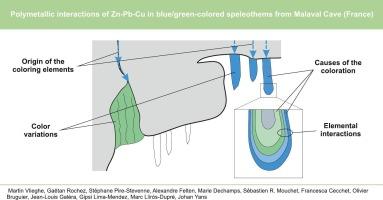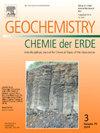Polymetallic interactions of Zn-Pb-Cu in blue/green-colored speleothems from Malaval Cave (France)
IF 2.9
3区 地球科学
Q2 GEOCHEMISTRY & GEOPHYSICS
引用次数: 0
Abstract
Speleothems rarely exhibit stunning colors such as red, yellow, green, or blue. The colorations are often linked to elevated heavy metal ion concentration in the drip water and thus to a metal source/pollution in the catchment area. Here the blue-green speleothems coloration in Malaval Cave (Lozère, France) is characterized by a wide panel of optical, mineralogical and geochemical techniques. These techniques were applied on several small blue or white stalactites and a larger greenish stalactite. The speleothems are mostly composed of aragonite and contain variable amounts of Zn, Cu and Pb, which cause the colorations. Zn and Cu are mostly present in substitution in the aragonite and Cu2+ is the main cause of the blue coloration. Zn is also found in small amorphous gel particles, containing minor amounts of Mg, Cu and Si. These phases are responsible for microscopical scale variations in the blue coloration. Pb is present as Pb2+ ions in substitution within the aragonite, creating a saturated blue-to-greenish coloration. This coloration may depend on the Pb/Zn ratio due to metallic interaction. Pb, Zn and Cu ratios indicate that Pb likely deposited from distinct fluids and at a different timing than Cu and Zn. All three metals likely originate from the leaching of Pb![]() Zn ores in the Jurassic formations surrounding the cave.
Zn ores in the Jurassic formations surrounding the cave.

法国Malaval洞蓝/绿色洞穴中锌-铅-铜多金属相互作用研究
洞穴主题很少表现出令人惊叹的颜色,如红色、黄色、绿色或蓝色。这些颜色通常与滴水中重金属离子浓度升高有关,因此与集水区的金属来源/污染有关。在这里,Malaval洞穴(loz,法国)的蓝绿色洞穴主题颜色是由广泛的光学,矿物学和地球化学技术组成的。这些技术应用在几个小的蓝色或白色钟乳石和一个较大的绿色钟乳石上。这些矿石大多由文石组成,并含有不同数量的锌、铜和铅,使其变色。Zn和Cu在文石中以取代态存在,Cu2+是文石呈蓝色的主要原因。锌也存在于小的无定形凝胶颗粒中,含有少量的Mg、Cu和Si。这些相是造成蓝色的微观尺度变化的原因。铅以Pb2+离子的形式存在于文石中,形成饱和的蓝绿色。由于金属相互作用,这种着色可能取决于Pb/Zn比。Pb、Zn和Cu比值表明Pb可能来自不同的流体,沉积时间与Cu和Zn不同。这三种金属可能都来自于洞穴周围侏罗纪地层中铅锌矿的浸出。
本文章由计算机程序翻译,如有差异,请以英文原文为准。
求助全文
约1分钟内获得全文
求助全文
来源期刊

Chemie Der Erde-Geochemistry
地学-地球化学与地球物理
CiteScore
7.10
自引率
0.00%
发文量
40
审稿时长
3.0 months
期刊介绍:
GEOCHEMISTRY was founded as Chemie der Erde 1914 in Jena, and, hence, is one of the oldest journals for geochemistry-related topics.
GEOCHEMISTRY (formerly Chemie der Erde / Geochemistry) publishes original research papers, short communications, reviews of selected topics, and high-class invited review articles addressed at broad geosciences audience. Publications dealing with interdisciplinary questions are particularly welcome. Young scientists are especially encouraged to submit their work. Contributions will be published exclusively in English. The journal, through very personalized consultation and its worldwide distribution, offers entry into the world of international scientific communication, and promotes interdisciplinary discussion on chemical problems in a broad spectrum of geosciences.
The following topics are covered by the expertise of the members of the editorial board (see below):
-cosmochemistry, meteoritics-
igneous, metamorphic, and sedimentary petrology-
volcanology-
low & high temperature geochemistry-
experimental - theoretical - field related studies-
mineralogy - crystallography-
environmental geosciences-
archaeometry
 求助内容:
求助内容: 应助结果提醒方式:
应助结果提醒方式:


